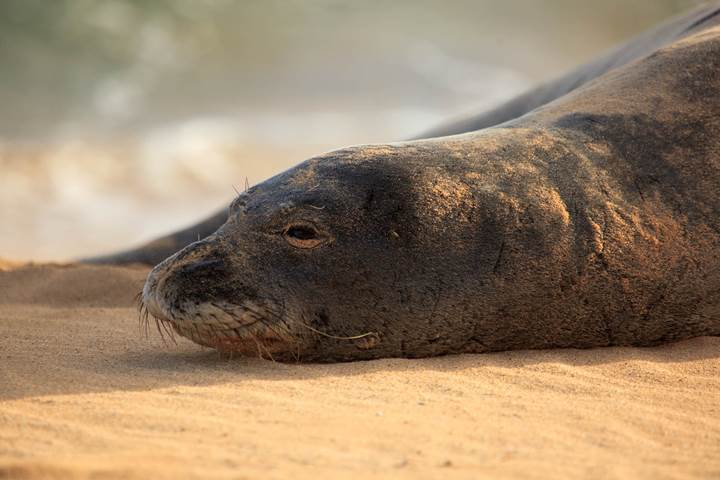To report a sighting, call NOAA Fisheries Monk Seal Hotline (808) 651-7668 or email PIFSC.monksealsighting@noaa.gov. If you see an injured or entangled animal, do not approach it, instead call 888-256-9840.
Also known as ‘ilio holo i ka uaua, the Hawaiian Monk Seal is the official Hawaii State Mammal and one of only two endemic mammals found in the State the other being the Hawaiian Hoary bat. They are playful and curious with big round eyes and floppy whiskers. Adult seals range from 5-7ft in length and can weigh 400-600lbs.
A newborn pup weighs about 25-30lbs but may grow to 200lbs before it is weaned five weeks after birth. Breeding and birthing can take place at any time but usually occurs during the warm spring and summer months. Monk Seals feed on a variety of marine life but prefer whatever is easiest to catch. This may include: lobster, crab, squid, eels, octopus and reef fish.
Monk Seals spend most of their time looking for food and avoiding predators. This can make them very tired and requires them to haul out onto the beach for extended periods of rest. Therefore, it is critical that they have a place to rest and that they are allowed to do so without interruption. Guidelines for viewing are designed to limit any such disturbance. As such, it is important to remain outside the yellow tape or barricades that often surround a seal on the beach, or at least 150ft away if they are in an unmarked area.
These guidelines are important because the Hawaiian Monk Seal is one of the most critically endangered animals in the world; only about 1100 individuals remain. It used to be that monk seals were rarely seen in the Main Hawaiian Islands, but now it is not uncommon to see seals hauled out on beaches all around Kauai. However, even with an increasing population in the Main Hawaiian Islands, their numbers have continued to decline in the Northwestern Hawaiians at a rate of 4.5% per year. It is estimated that their population may soon fall below 1000 individuals.
The Hawaiian Monk Seals face many obstacles to recovery. Populations in the NWHI are subject to shark predation, and malnutrition from lack of food. Ocean debris such as fishing nets continues to threaten populations with entanglement. On some islands, male seals outnumber females and mating season can be a dangerous time. Females may suffer severe bites from multiple acts of aggression. Human disturbance can cause seals to seek safety in the water only to fall victim to predation from sharks. Juveniles are especially susceptible.
Scientists have been working hard to learn more about the seals and their population dynamics. Efforts to slow their rate of decline and increase the population have included: relocating juveniles shortly after birth to safer locations, supplemental feeding, relocating males on islands where they outnumber the females, disentangling distressed animals, removing ocean debris and educating the public. In many instances, these efforts have resulted in increased juvenile and female survival.


